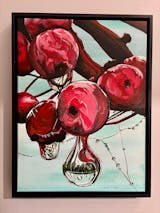The Sisters Bloom animation studio created their first eco-friendly animation last year, featuring our watercolor recipe! They graciously shared their process with us; check it out!
“We are so excited to share our first eco-friendly animation, created for Mt. Meru Medicines, a turmeric supplement company going back to their roots and producing pure, small-batch products for immunity and overall health. This turmeric is so high-quality and vibrant we immediately knew the video should be brought to life with the natural colors turmeric can yield. Everything you see on screen is hand-crafted with organic fabrics and fibers, plant-based glue, natural clay handmade with locally-sourced ingredients, and, of course, Mt. Meru's turmeric!
Here’s a little insight into how we brought Mt. Meru’s story to life:
Radhika provided us with plenty of reference photos from her time in India visiting her farmers and setting up her production. But our favorite reference was the authentic tribal dolls handmade by artisans in India. This sealed the deal on whether or not to make puppets. The original is pretty amazing, but we were able to translate the essence into our turmeric-dyed puppets, making sure to embody the costumes unique to the tribal farmers responsible for Mt. Meru’s turmeric.

The puppet armatures provided a great starting point for innovating a new puppet-making technique. We started with the standard aluminum and steel wires, stuck them together with natural glue we made from methyl-cellulose powder, and wrapped them with organic cotton thread. Rather than creating grab points with toxic plumber’s epoxy, we wrapped the chest, hips, and heads with organic cotton string. Of course we have more experimenting to do, but since the puppets were shot on a downshooter, and therefore not weight-bearing, this worked great for our purposes. We then covered the armatures in organic cotton batting rather than conventional foam.

We dyed all the fabrics and fibers by making what’s called a “lake,” which is just the process of boiling a natural ingredient like turmeric in water. We then dipped various fabrics and fibers into the colored water for different lengths of time to get the various shades of yellow-orange.
We also made our own clay, because we just weren’t happy with anything out there labeled “natural.” We bought some beeswax from our local farmer’s market and used that as the base. For our first try, it wasn’t bad and animated well after a lot of warming up by hand. (Okay, it was a little too much of a hand workout!) We look forward to perfecting this clay when a future project requires it.

The trickiest fabrication element was the hand-written map. We did it all in-camera, so it took two tries. The first time we used the turmeric lake from dyeing fabric, which was much too watery and needed several coats plus extra drying time. So we tried again making a watercolor recipe provided by our affiliate, Natural Earth Paint. This time the ink was thick enough to only need one coat and dried pretty quickly.
The watercolor recipe was really easy to follow. We just made the watercolor base and added enough of the natural turmeric powder to get the color we desired. We kept it liquid rather than letting it dry out into a cake and it worked great as a natural ink using calligraphy pens as well as for a homemade cork stamp. We're storing the leftover base in an airtight jar and it’s still holding up.

We also did some last-minute improvising and made our own stamps from cork. And in case you were wondering, for all the powdered segments we made our own stencils.

It’s pretty incredible how versatile this project turned out to be. Special thanks to Reece Miller for helping us set up our sound-recording equipment and for creating music and sound that really brought the visuals to life!”
Check out their vibrant final animation below!
Interested in learning more about Natural Earth Paint artists? Visit our Eco Artists page!
Follow us on Instagram, Facebook, and Pinterest for more natural inspiration.







